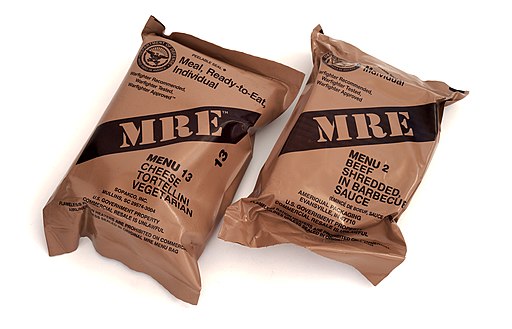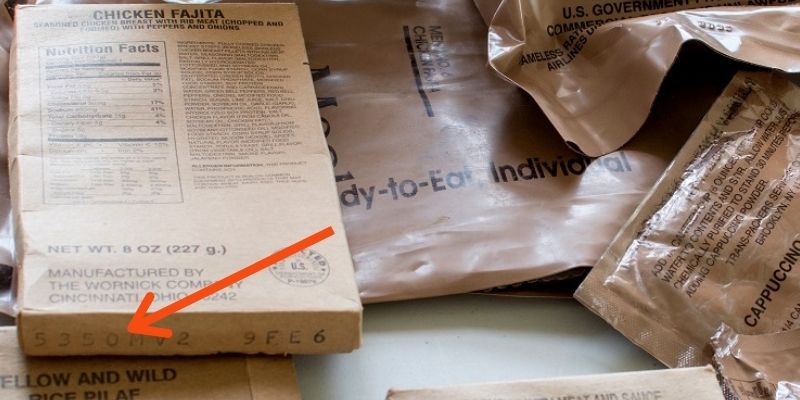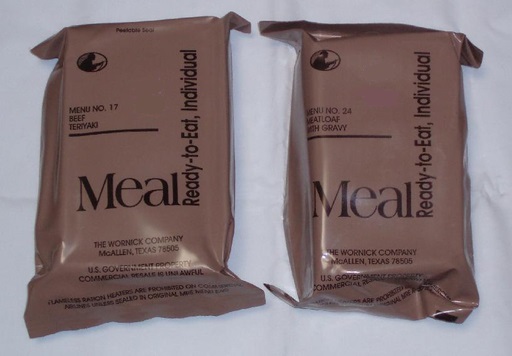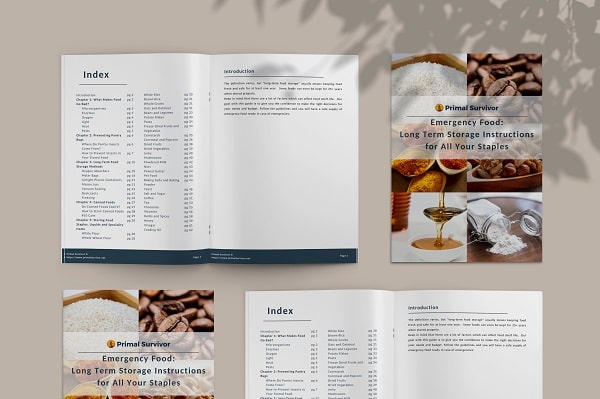Ready-to-eat meals, or MREs, are military field rations becoming increasingly popular with preppers. It’s illegal to sell military MREs (although they sometimes pop up on eBay), but several companies sell similar products for civilians.
MREs don’t have a set expiration date, and their shelf life is temperature-dependent.
So how are you supposed to know how long they’ll last?
That’s the question we’ll answer in this article.
What Do MREs Contain?

Each MRE contains everything you need for one meal.
This typically includes an entrée, side dish, crackers, spread, dessert, candy, hot drinks (e.g., instant coffee, milk powder, and sugar), and snacks or candy.
They may also include a spoon or spork, a napkin, and a flameless heater for warming up your entrée.
Military MREs contain around 1,250 calories, though civilian equivalents are sometimes slightly less. Three meals a day would still give you more calories than most people need.
Making Sense of MRE Date Stamps

Most MREs aren’t stamped with an expiration date, as their shelf life depends on how they’re stored.
Instead, they’re stamped with a manufacturing date, which you can use to calculate the age of your rations.
Unfortunately, it’s not quite as simple as looking for a “June 2020” label…
Your MRE might be stamped with various numbers and codes, but you’re looking for a four-digit code.
The first digit indicates the year of manufacture. For example, a “4” would be 2014, and a “9” would be 2019.
The remaining three digits tell you the day of the year. June 19 is represented as 169.
So, in the above image, you can see a code of 5350, which indicates a manufacturing date of December 16, 2015.
Use our MRE date code converter to check the dates on your MREs quickly
Once you know the manufacture date, you’ll have a reasonable idea of whether your food is still good.
How Long do MREs last?
Note MREs don’t have a specific expiration date, but an average MRE stored at 80 degrees Fahrenheit will be safe to eat for up to three years. If stored at much cooler temperatures, some or all of the contents could be good for up to five years. Conversely, if allowed to bake in the Texan sun, they might last as little as one or two months.
If you don’t know what conditions your MREs have been stored in, the manufacture date may not be helpful. Equally, just because an MRE is a few months past the three-year mark doesn’t mean it’s unsafe to eat.
Some further detective work might be needed…
Signs That Your MRE Might Not Be Good to Eat

If you find an old yogurt pot at the back of your refrigerator, chances are you’ll sniff it before tossing it out. Well, you can do the same with your MREs.
Signs that an MRE might be past its best include:
- Damaged packaging. Perforations or weaknesses in the laminated pouches could allow air in, spoiling the contents.
- The bag is swollen. This can indicate that bacteria causing botulism could be present. Botulism is a rare but severe illness, and it’s not worth taking a risk on. If your MRE looks bloated, ditch the pack.
- You know (or suspect) it has been stored at a high temperature.
- It smells off or tastes funny when you eat it.
Cases of military MREs have a Time Temperature Indicator label consisting of a two-part circular indicator. The inner circle darkens with time and at higher temperatures. If it’s darker than the outer circle, the MRE has exceeded its recommended shelf life. (source)
Remember that some parts of an MRE won’t last as long as others. Cheese spreads, peanut butter, and applesauce typically go off faster than packaged meals or candy.
How to Store MREs to Maximise Shelf Life
MREs are not cheap, so you want to ensure they last as long as possible, especially if you don’t use them daily.
You can maximize storage life by purchasing new cases of MREs. Getting a deal on second-hand meals might feel like a cost saving at the time, but if you have to replace them in two years rather than five, you’ll end up out of pocket in the long run.
Like most food, MREs are best stored in cool, dry temperatures away from direct sunlight. Although they’re robustly packaged and shouldn’t be damaged by water or tempting to rodents, it’s worth keeping them off the ground to be safe.
It’s not generally recommended that you freeze MREs. Freezing can damage the laminated pouch, particularly if the contents are thawed and refrozen several times (e.g. if you have a power cut). However, freezing would extend the shelf life, so it may be a risk you’re willing to take.
You don’t want to reach for your MREs in a disaster only to find they’re four years out of date, so check your stock regularly and rotate meals out as needed.
How to Use MREs in Your Prepping Food Stash
MREs are a medium-long term emergency food option. They’ll last longer than your grocery-store cans and packets but not as long as dehydrated and freeze-dried emergency food.
You may feel that having a short-term stockpile and a bunch of 20+ year meals is a better option than adding a third element to your food stash, but MREs have two significant advantages over freeze-dried food:
- They can be eaten hot or cold.
- You don’t need to add water to prepare them.
If you have limited clean water, you can prioritize that water for drinking. Eating them cold means you don’t have to worry about electricity, gas, or lighting a fire if it isn’t safe (though many MREs come with a fireless heating kit).
Each MRE is packaged as a complete meal, so they’re an easy option if you need to grab food and run. There’s no risk of ending up just with dessert or forgetting the sugar for your coffee; you know you’re getting a set number of calories in each packet.
For more, see our post about how to cook MREs
Where Can I Buy MREs?
You can buy MREs in various places, from online distributors to shady dealers. We’d always recommend buying from a retailer you can trust. We’ve compiled a list of the cheapest places to buy MREs online to simplify things.
If you’re on a budget, follow a special diet, or want to control exactly what’s going into your food, you can make your own MREs. Check out our guide on making your own survival MREs for instructions. Also, remember that MREs are only suitable for short-term emergencies – read are MREs healthy?



Thank you for the info. It was helpful.
Is it possible that to take a 20 year old MRE having been properly stores;
package still in excellent condition and w/o indications of breach or swelling
and does not smell or look bad when opened …. To place in a pot with water and cayenne pepper sauce , heat above 165 degrees and sample taste for
fit to consume ?
Yes!
With the constant changes in temperature & extreme heat, I imagine they went bad in under a month unless you’re way up north.
Thanks for the info! We have some MREs in a car emergency kit, so it’s good to know we can probably throw them out since they’re 5+ years old, ha.